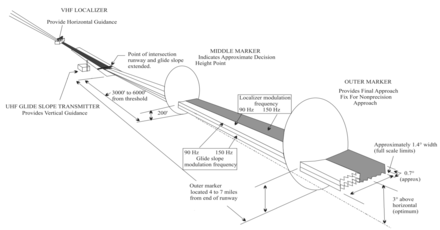
Back نظام هبوط الأجهزة Arabic Cihazlarla Enmə Sistemi Azerbaijani Instrument landing system Bulgarian Sistema d'aterratge instrumental Catalan Instrument landing system Czech Instrumentlandingssystem Danish Instrumentenlandesystem German Sistema de aterrizaje instrumental Spanish Instrumentaalmaandumissüsteem Estonian سیستم فرود ابزاری Persian

In aviation, the instrument landing system (ILS) is a precision radio navigation system that provides short-range guidance to aircraft to allow them to approach a runway at night or in bad weather. In its original form, it allows an aircraft to approach until it is 200 feet (61 m) over the ground, within a 1⁄2 mile (800 m) of the runway. At that point the runway should be visible to the pilot; if it is not, they perform a missed approach. Bringing the aircraft this close to the runway dramatically increases the range of weather conditions in which a safe landing can be made. Other versions of the system, or "categories", have further reduced the minimum altitudes, runway visual ranges (RVRs), and transmitter and monitoring configurations designed depending on the normal expected weather patterns and airport safety requirements.

ILS uses two directional radio signals, the localizer (108 to 112 MHz frequency), which provides horizontal guidance, and the glideslope (329.15 to 335 MHz frequency) for vertical guidance. The relationship between the aircraft's position and these signals is displayed on an aircraft instrument, often additional pointers in the attitude indicator. The pilot attempts to manoeuvre the aircraft to keep the indicators centered while they approach the runway to the decision height. Optional marker beacon(s) provide distance information as the approach proceeds, including the middle marker (MM), placed close to the position of the (CAT 1) decision height. Markers are largely being phased out and replaced by distance measuring equipment (DME). The ILS usually includes high-intensity lighting at the end of the runways to help the pilot locate the runway and transition from the approach to a visual landing.[1]
A number of radio-based landing systems were developed between the 1920s and 1940s, notably the Lorenz beam which saw relatively wide use in Europe prior to World War II. The US-developed SCS-51 system was more accurate while also adding vertical guidance. Many sets were installed at airbases in the United Kingdom during World War II, which led to it being selected as the international standard after the formation of the International Civil Aviation Organization (ICAO) in 1947. Several competing landing systems have been developed, including the radar-based ground-controlled approach (GCA) and the more recent microwave landing system (MLS), but few of these systems have been deployed. ILS remains a widespread standard to this day.
The introduction of precision approaches using global navigation satellite systems (GNSSs) instead of requiring expensive airport infrastructure is leading to the replacement of ILS. Providing the required accuracy with GNSS normally requires only a low-power omnidirectional augmentation signal to be broadcast from the airport, which is dramatically less expensive than the multiple, large and powerful transmitters required for a full ILS implementation. By 2015, the number of US airports supporting ILS-like LPV approaches exceeded the number of ILS installations,[2] and this is expected to lead to the eventual removal of ILS at most airports.
- ^ Wragg, David W. (1973). A Dictionary of Aviation (1st ed.). Osprey. p. 143. ISBN 9780850451634.
- ^ "Satellite Navigation - GPS/WAAS Approaches".